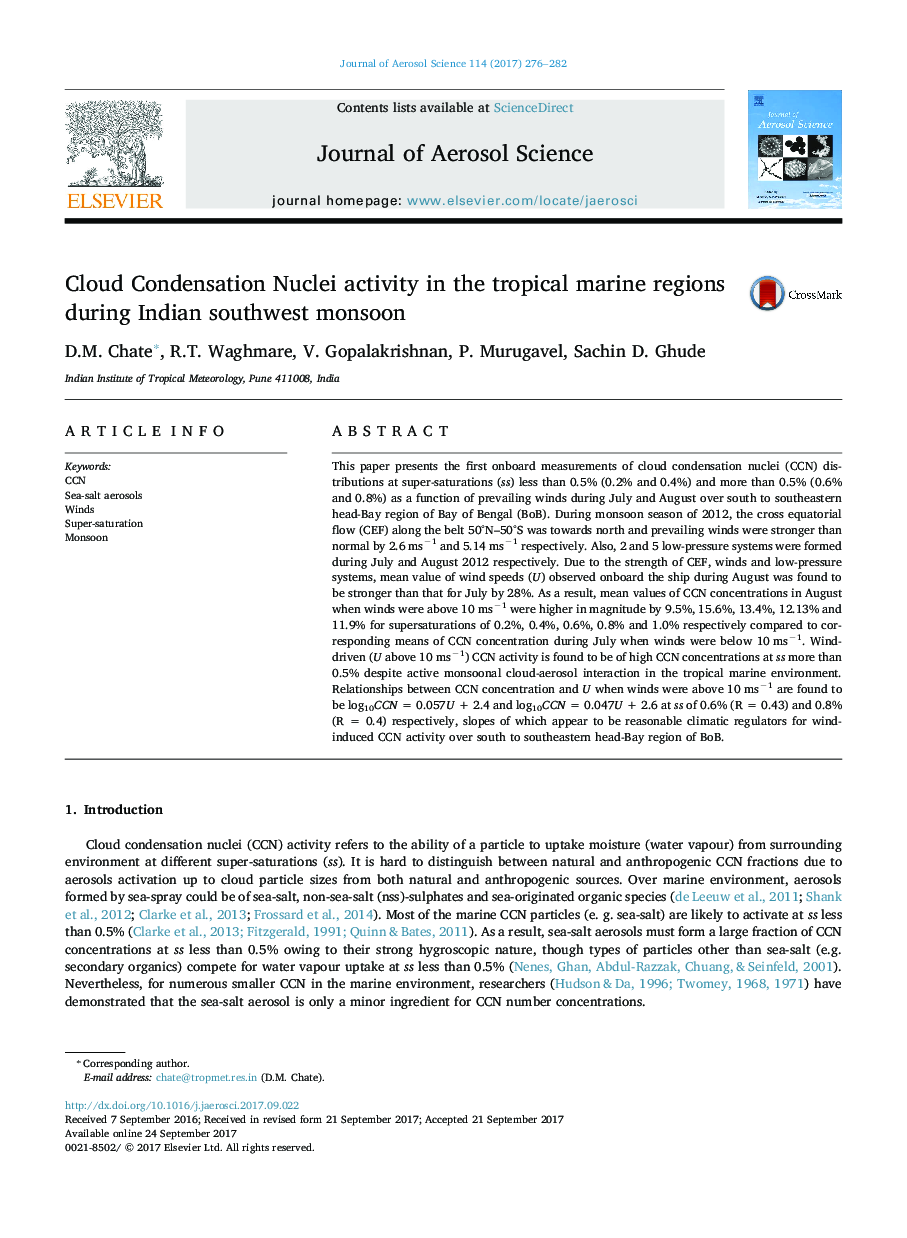| کد مقاله | کد نشریه | سال انتشار | مقاله انگلیسی | نسخه تمام متن |
|---|---|---|---|---|
| 5753882 | 1620709 | 2017 | 7 صفحه PDF | دانلود رایگان |
- CCN distributions are presented for a wide range of supersaturations in the marine environment of Bay of Bengal.
- CCN concentration increases with prevailing winds.
- The results are relevant to the cloud microphysics and climate change impacts.
This paper presents the first onboard measurements of cloud condensation nuclei (CCN) distributions at super-saturations (ss) less than 0.5% (0.2% and 0.4%) and more than 0.5% (0.6% and 0.8%) as a function of prevailing winds during July and August over south to southeastern head-Bay region of Bay of Bengal (BoB). During monsoon season of 2012, the cross equatorial flow (CEF) along the belt 50°N-50°S was towards north and prevailing winds were stronger than normal by 2.6 msâ1 and 5.14 msâ1 respectively. Also, 2 and 5 low-pressure systems were formed during July and August 2012 respectively. Due to the strength of CEF, winds and low-pressure systems, mean value of wind speeds (U) observed onboard the ship during August was found to be stronger than that for July by 28%. As a result, mean values of CCN concentrations in August when winds were above 10 msâ1 were higher in magnitude by 9.5%, 15.6%, 13.4%, 12.13% and 11.9% for supersaturations of 0.2%, 0.4%, 0.6%, 0.8% and 1.0% respectively compared to corresponding means of CCN concentration during July when winds were below 10 msâ1. Wind-driven (U above 10 msâ1) CCN activity is found to be of high CCN concentrations at ss more than 0.5% despite active monsoonal cloud-aerosol interaction in the tropical marine environment. Relationships between CCN concentration and U when winds were above 10 msâ1 are found to be log10CCN = 0.057U + 2.4 and log10CCN = 0.047U + 2.6 at ss of 0.6% (R = 0.43) and 0.8% (R = 0.4) respectively, slopes of which appear to be reasonable climatic regulators for wind-induced CCN activity over south to southeastern head-Bay region of BoB.
It is worth to note that during its return journey towards south at Chennai port, SK-296 cruise sailed relatively away from the southeast coastline, where prevailing air mass were with U>10Â msâ1 (August 2012). For August, relationships between CCN concentrations and wind speed (U > 10Â msâ1) are log10CCN = 0.057U + 2.4 with the slope m (CCN to wind speed) of 0.057 for CCN concentrations activated at ss of 0.6%. For U > 10Â msâ1 in the central Indian Ocean, shipboard measurements of Bigg, et al., (1995) suggested a relationship as log10CCN=0.04U+0.94 for CCN concentrations activated at ss of 0.6%.106
Journal: Journal of Aerosol Science - Volume 114, December 2017, Pages 276-282
